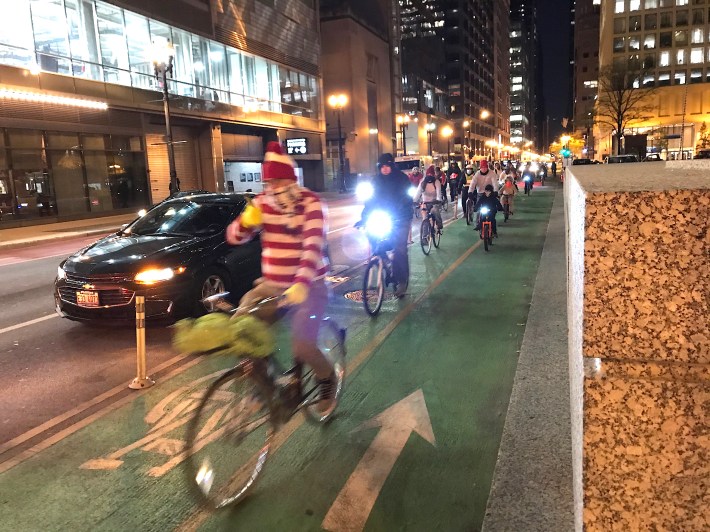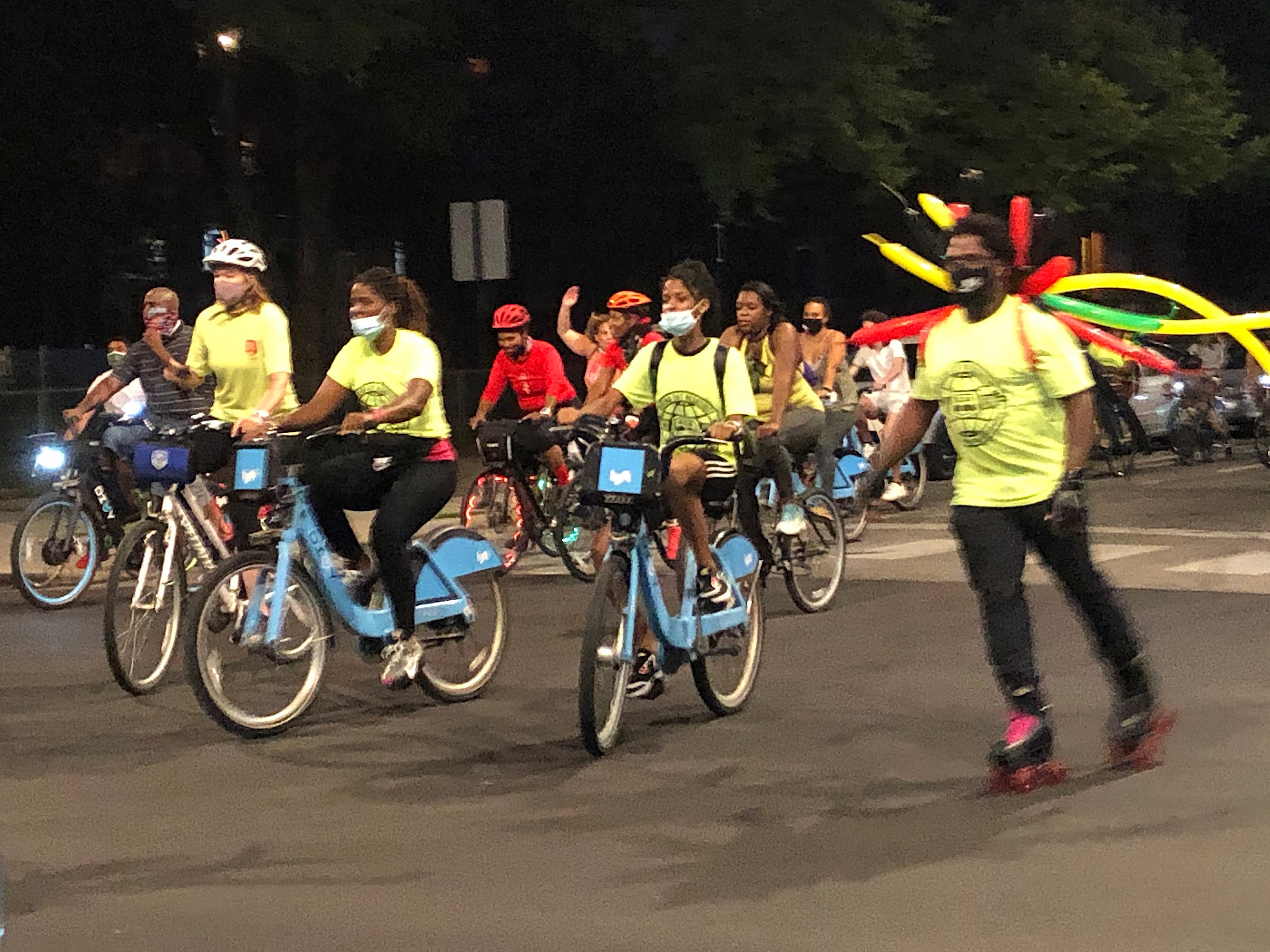Community bike rides have been one of the few group activities deemed relatively low-risk by many during the COVID-19 pandemic. While Critical Mass riders wisely chose not to do the usual monthly event in the uncertainty of the early pandemic days, group rides gradually came back through the summer as research on transmission of the virus developed and safety guidelines were agreed upon by public health experts.
In the wake of the George Floyd protests and an increase in Chicago homicides, rides promoting racial justice, public safety, and neighborhood unity led by the mobility justice group Equiticity and other local organizations were much-needed sources of community connection and stress-busting physical activity during traumatic times. Happily, no outbreaks have been attributed to large group rides to date, but with positivity rates on a steep rise again, and contact tracing in the U.S. scrambling to catch up, safety during group rides is worth a second look.
Yasmeen Schuller, owner of The Chainlink, a social networking site for Chicago cyclists, recently posted guidelines for group ride organizers wising to promote events on the site’s event calendar:
1. Mask requirements - have your riders wear masks on your rides. Say it in the event description.
2. Social distancing - encourage keeping safe distance from one another to avoid spray and spread.
3. Limit the numbers* - put a cap on the number of people and/or make a plan to split the ride into safer, smaller groups. If this is impossible and you expect hundreds, is this a good idea to hold a ride?
*How many is "safe"? Well, there's going to be risk any time you are riding with people outside your household. What will be approved? The recommendations I am hearing is no more than ten together but with careful distance. I will be willing to work with you on this point. I have made exceptions for peace and protest rides because protest and voting are activities that are necessary. I have also asked that language be added for social distancing and masks and organizers have added it with no question.
The first two points are of course nothing new: Putting on a mask and keeping six feet of distance from others are the look-both-ways-before-crossing of common-sense behaviors when leaving the house in 2020. But Schuller’s third point and footnote get into grayer terrain of risk-assessment: just how many riders is “safe?” No one outside your household? Unlimited, so long as six feet of distance is maintained? Something in between? And, once that rule is decided on, what constitutes a necessary exception?
Dr. Sarah Cobey, an epidemiologist at the University of Chicago who develops predictive virus models, said that the risk of COVID transmission on group rides is, indeed, challenging to determine. “It's difficult to say how risky they are,” she said. “Obviously they're riskier than riding alone. Larger group rides are riskier than smaller group rides and maintaining more distance will decrease the risk of infection. If it were me, and I could maintain my sanity by cycling some other way, I would. The infection risk isn't zero at six feet. Definitely no drafting. People should not be talking or yelling over their shoulder at one another.”
When I asked Dr. Cobey if she recommended capping the size of rides or calling off events where a very large number of participants were expected, her response was, “probably.” She added, “I think it's fair to say that modeling airflow is very difficult, and I'm sure you can find simulations where there's very little risk of infection even with cyclists quite close to each other. But people will not maintain perfect form, so there will be turbulence [unpredictable airflow], and people will be breathing dry air very hard. Sometimes they will breathe in others' exhalations. That's all a recipe for transmission, even though the risk is probably lower than from dining indoors in poorly ventilated spaces. I doubt we'd get a super-spreading event from a ride in which people generally maintained distance, were masked, and didn't shout at each other. That doesn't mean transmission would be zero.”

Juan Dominguez, who submitted a route for last month's Chicago Critical Mass Halloween ride, echoed the importance of wearing masks on group rides to minimize transmission. “It’s better to mask up and be outside then in groups in enclosed spaces," he said. Dominguez added that capping the number of riders for a decentralized, leaderless event like Critical Mass would be difficult, but with the onset of the cold weather, the number of participants will likely decrease to the extent that capping numbers would, at least for the next few months, be a non-issue.
Dominguez added that large rides he has participated in on the South Side have been a success, with no subsequent outbreaks reported. “I’ve been doing a lot of group rides on the South Side with Equiticity and South Side Critical Mass, and those people continue to gather in large groups -- 50, 100, 200 -- they would encourage people to wear masks, give free masks away and it’s worked well.”
Equiticity leader Oboi Reed said the many group rides in Black Chicago communities this summer and fall were prompted by the spike in violence in his neighborhood, North Lawndale, during the pandemic. “The first ride I was part of organizing was the Street Love ride in August. There was a significant increase of violence in North Lawndale and a number of predominantly Black and brown neighborhoods,” he said. “It was a tough decision to make, but faced with increasing violence, increasing isolation, increasing stress in ways we still don’t understand the impact it’s going to have on us, I was willing to take a calculated risk to use community rides as a vehicle to address these contemporary problems. We haven’t experienced anything like this.”
Reed said he took multiple measures to help keep the ride safe: communicating regularly in advance that masks should be worn and that anyone exhibiting symptoms should stay home, giving out free masks at the event, providing ample hand sanitizer and reminding riders to maintain distance from one another. The success of the Street Love gave Reed confidence to continue holding community rides while keeping people safe.
“In the grand scheme of things, we do consider community mobility rituals like bicycle rides and neighborhood walking tours as strategies to improve our neighborhoods,” Reed said. “And in the context of COVID, we do see them as important vehicles to offer people who are having a hard time with COVID. In some instances, with the right measures in place, we see our work as critical, and in some cases, worthy of the risk. However, we are not ignoring the risk and are certainly cautious and thoughtful about how we use these activities to do more good in our neighborhood than harm.”





